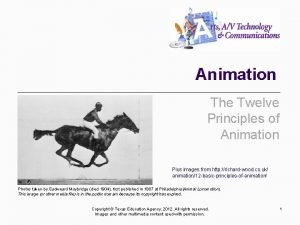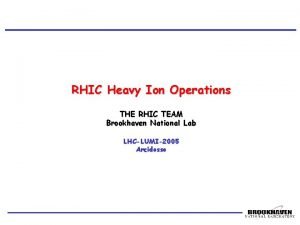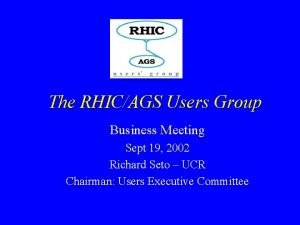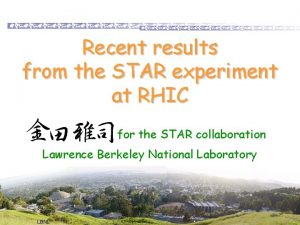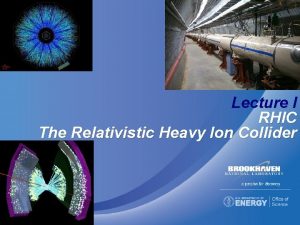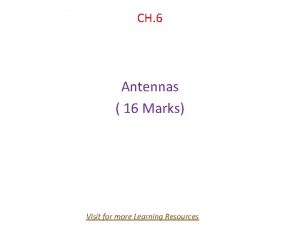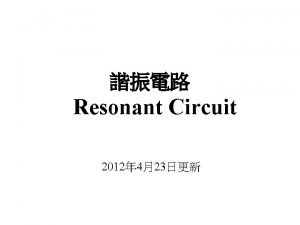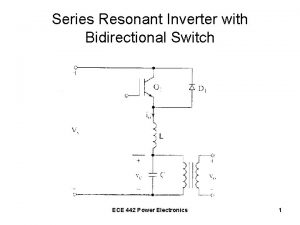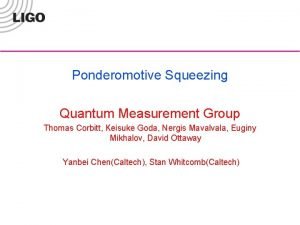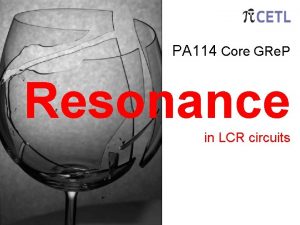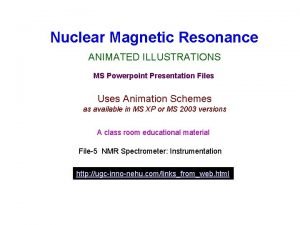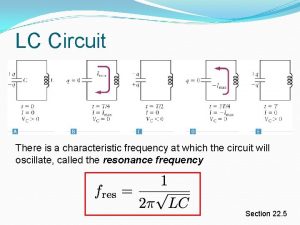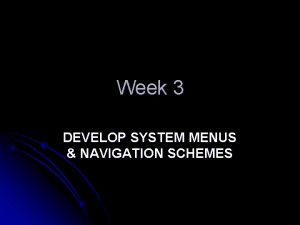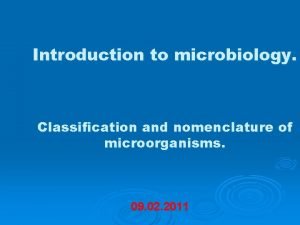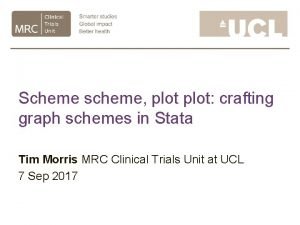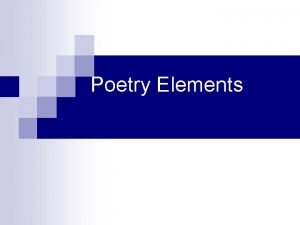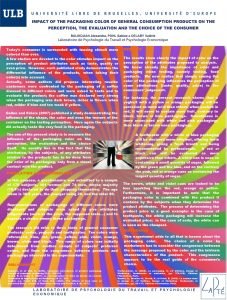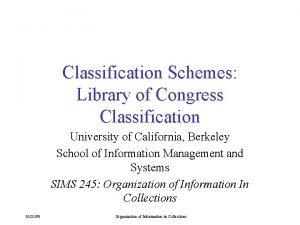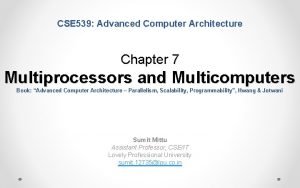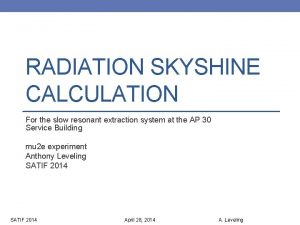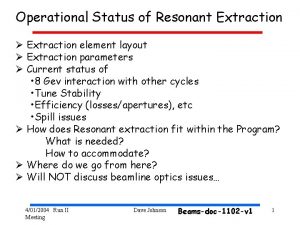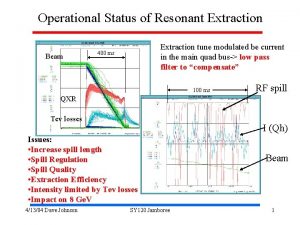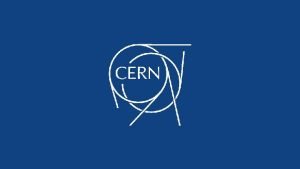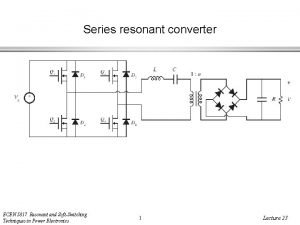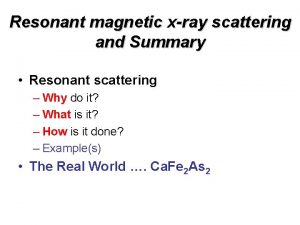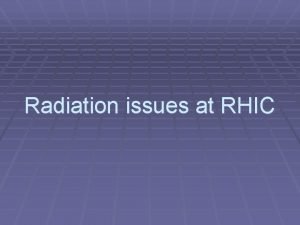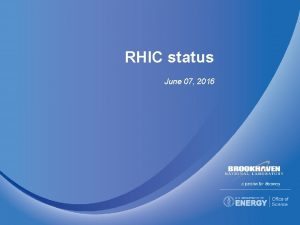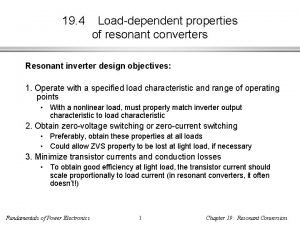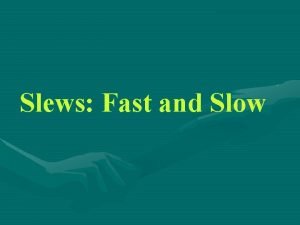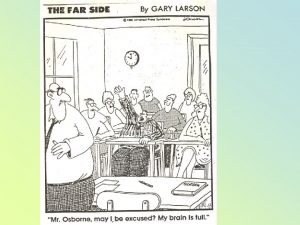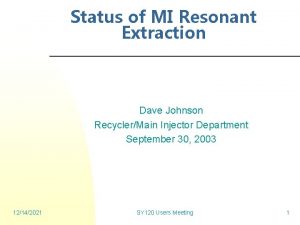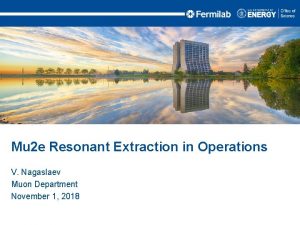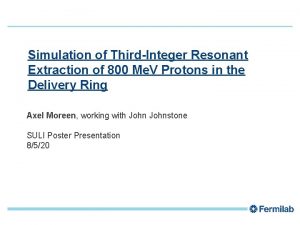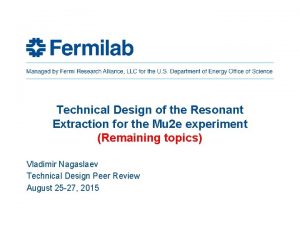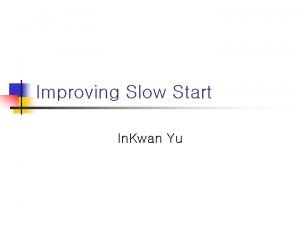Slow and Fast Resonant Extraction Schemes for RHIC
















![x’ [rad] Resonant Extraction Phase Space at 10 o’clock region: Particle Tracking x [m] x’ [rad] Resonant Extraction Phase Space at 10 o’clock region: Particle Tracking x [m]](https://slidetodoc.com/presentation_image/833867bfa81d95b344e2b5687029e4b6/image-17.jpg)











- Slides: 28

Slow and Fast Resonant Extraction Schemes for RHIC Kevin Brown BNL

Outline • • Oct. 31, 2010 Methods for resonant extraction Parameters Possible Locations for equipment Projected Costs Possible timelines to realize new systems Possible beam studies to test ideas Summary Drell-Yang Workshop, 2010 2

Methods for Resonant Extraction Two possible approaches 1. Traditional 2/3 integer slow extraction • • Beam needs to remain bunched (for polarization data) Beam is very rigid; 250 Ge. V Require very high efficiency (< 1% beam loss) Spill structure requirements? 2. Resonant island fast extraction • • • Oct. 31, 2010 Method developed at CERN PS Drive (adiabatically) particles into 3 transverse phase space islands using nonlinear elements Can either kick all beam out in 3 turns Or can single kick each bunch out over some time period Either way, kicker systems are very challenging to build Drell-Yang Workshop, 2010 3

Parameters • Energy = 250 Ge. V • Qx = 28. 67 (86/3), Qy = 29. 685, chroms ~+2/Q • Species = polarized protons – Beam needs to remain bunched to retain polarization – (bunch pattern set by STAR/PHENIX) • Intensity ~ 2 e 11/bunch, 111 bunches/rev (max) – Total ~ 22 e 12 protons/cycle • Spill at end of RHIC store, one spill per 10 hours – About 200 spills/yr = 4. 4 e 15 protons/yr – With ~1% loss, about 4. 4 e 13, 250 Ge. V proton loss/yr (slow extraction case, fast extraction should have lower losses) [for comparison: AGS, 1. 5 e 20 p/yr, losing 2%= 3 e 18 25 Ge. V p/yr] Oct. 31, 2010 Drell-Yang Workshop, 2010 4

Possible Locations for equipment • Slow Extraction – Need long electrostatic septa (2 or 3 modules) [ES] (at 1 cm gap, 100 k. V/cm gradient, need 10 meters of septa) – Need 4 or more magnetic septa [MS] – All/most beam loss is on ES – Locate ES between abort kicker and dump (10 O’clock) – Locate MS in 2 O’clock region • Fast resonant island extraction – Need multiple c-magnet type kickers – Require MS to separate kicked beams • Both systems will require • bumps to move beam into proper locations for extracting beam • un-squeeze b* (don’t want beam hitting in triplets) Oct. 31, 2010 Drell-Yang Workshop, 2010 5

RF Jet/Polarimeter STAR Dumps Oct. 31, 2010 Drell-Yang Workshop, 2010 PHENIX 6

~30 m IP 02 Oct. 31, 2010 Drell-Yang Workshop, 2010 7

Oct. 31, 2010 Drell-Yang Workshop, 2010 8

2 O’clock Interaction Region Extraction Septa need to fit here. Blue Ring on Outside. Blue Ring on Inside. Technical problem: Septa bend out from inner ring. Oct. 31, 2010 Drell-Yang Workshop, 2010 9

~ 1 m Oct. 31, 2010 Drell-Yang Workshop, 2010 10

~ 1° Oct. 31, 2010 Drell-Yang Workshop, 2010 11

Oct. 31, 2010 Drell-Yang Workshop, 2010 12

10 O’clock Region for ES or Kickers (? ) Oct. 31, 2010 Drell-Yang Workshop, 2010 13

Qy=29+ Qx=28 2/3 Qx = 28+ Oct. 31, 2010 Drell-Yang Workshop, 2010 14

Resonant Extraction: Analytical Picture 1 3 ES 2 Separatrix just after 10 o’clock dump kickers where a possible ES could be located. Oct. 31, 2010 Drell-Yang Workshop, 2010 15

Resonant Extraction: Analytical Picture 1 3 TMS 2 Separatrix just after Q 4 in 2 nd Sextant (start of 2 o’clock IR) where a possible Thin MS (TMS) could be located. Oct. 31, 2010 Drell-Yang Workshop, 2010 16
![x rad Resonant Extraction Phase Space at 10 oclock region Particle Tracking x m x’ [rad] Resonant Extraction Phase Space at 10 o’clock region: Particle Tracking x [m]](https://slidetodoc.com/presentation_image/833867bfa81d95b344e2b5687029e4b6/image-17.jpg)
x’ [rad] Resonant Extraction Phase Space at 10 o’clock region: Particle Tracking x [m] Oct. 31, 2010 Drell-Yang Workshop, 2010 17

Devices for JPARC Slow Extraction (30 -50 Ge. V/c) 2 2 x 5? 7 For 250 Ge. V, mostly need long ES/TMS ES ~ 10 m TMS ~ 15 m M. Tomizawa et al. , submitted to PRST-AB, 2010. Oct. 31, 2010 Drell-Yang Workshop, 2010 18

Septa devices for JPARC Slow Extraction M. Tomizawa et al. , submitted to PRST-AB, 2010. Oct. 31, 2010 Drell-Yang Workshop, 2010 19

Extraction Septa in the CERN SPS for Slow Extraction Systems Oct. 31, 2010 Drell-Yang Workshop, 2010 20

CERN PS Electrostatic Septa Adjustable gap. Circulating beam J. Borburgh et al. , Proceedings of the 2003 Particle Accelerator Conference Oct. 31, 2010 Drell-Yang Workshop, 2010 21

SPS Septa for SPS to LHC Extraction (450 Ge. V/c) J. Borburgh, et al. , LHC Project Report 911 Oct. 31, 2010 Drell-Yang Workshop, 2010 22

Resonant island fast extraction • Same basic configuration as Slow Extraction – Replace ES with kickers – Still use thin MS and thick MS at 2 o’clock • Kickers options – Abort style = in 1 to 3 turns extract all beam – Single bunch style = 100 nsec rise/fall time, c -magnet needs to be ~ 5 to 10 m long (in sections) – Controlling orbit in long kicker is a challenge (sections may need to be movable) Oct. 31, 2010 Drell-Yang Workshop, 2010 23

Resonance Islands at 2/3 Integer Start with 111 single bunches End with 333 single bunches R Cappi & M. Giovannozzi, PRSTAB Vol. 7, 024001 (2004) Oct. 31, 2010 Drell-Yang Workshop, 2010 24

Projected Costs (educated guessing) • • Expect ~$0. 25 M/m for ES, Need ~10 m = $2. 5 M Expect ~$0. 25 M/m for Thin MS, Need ~5 m = $1. 25 M Expect ~$0. 2 M/m for Thick MS, Need ~10 m = $2. 0 M PS’s for septa? – ES ~$0. 15/modules, 4 modules = $0. 6 M – Thin MS ~$0. 5 M – Thick MS ~$0. 25 M/module, 5 modules(? ) = $1. 25 M • Sext. PS’s, Bump Magnets + PS’s = $1. 5 M Total: ~$10 M + (shielding, instrumentation, controls, etc. ) Costs for Fast Resonant System are similar. Oct. 31, 2010 Drell-Yang Workshop, 2010 25

Possible timelines to realize new systems • Define detailed specifications = 3 to 6 months – Mostly physicists time – Some initial engineering calculations • Work out detailed designs = 1 to 1 ½ years – – Assume 1 ME for each septum type (ES, TMS, MS) Assume spec’s change some as more detailed calculations are done Assume full funding and mostly FT for engineers (>50%) Assume time needed for prototyping and engineering testing • Build units = 2 years – – Many dependencies, since so many units are needed. Need full funding for entire time Assume BNL shops are readily available for full time. Given large number septa needed, 2 years may be aggressive. • Field mapping, installation, and commissioning = 1 ½ years – Field mapping overlaps with building units, so not consecutive Total est. time = 4 to 5 years (consistent with other projects - JPARC, SPS, etc) Oct. 31, 2010 Drell-Yang Workshop, 2010 26

Possible beam studies to test ideas • Study of resonance islands – study 2/3 int. resonance conditions • Moving particles into islands • Phase space reconstruction (if we have instrumentation) • Tests to compare to simulations – Could inquire if CERN would be interested in collaborating (we all know each other …) – May require ps’s for sextupole configurations Oct. 31, 2010 Drell-Yang Workshop, 2010 27

Summary • Both fast and slow resonant extraction are possible in RHIC. Standard systems, but push design limits. • For slow extraction two significant issues – Design goal would be to keep <1% loss – Could be challenging to keep track of polarization pattern during a beam spill (what is polarization of first microbunch extracted? Abort can gap be used as a reference. ) • For fast extraction there is always some beam left over – abort kickers can dump it • Both systems are expensive and take time to design and build. • Some beam experiments should be done to test the models and understand resonance conditions. Oct. 31, 2010 Drell-Yang Workshop, 2010 28
 Slow in slow out animation
Slow in slow out animation Rhic brookhaven
Rhic brookhaven Rhic ags users meeting 2020
Rhic ags users meeting 2020 Rhic
Rhic Rhic
Rhic Fast twitch and slow twitch muscles
Fast twitch and slow twitch muscles Fast clock to slow clock synchronization
Fast clock to slow clock synchronization Opposites fast
Opposites fast Current and voltage distribution in antenna
Current and voltage distribution in antenna Rlc q factor
Rlc q factor Series resonant inverter with bidirectional switches
Series resonant inverter with bidirectional switches Fluid valve
Fluid valve Kyle corbitt
Kyle corbitt Resonant frequency formula
Resonant frequency formula Resonant inductive coupling ppt
Resonant inductive coupling ppt Resonant frequency formula
Resonant frequency formula Acid fast vs non acid fast
Acid fast vs non acid fast Non acid fast bacteria
Non acid fast bacteria New and navigation schemes selection of window
New and navigation schemes selection of window Bacteria kingdom, phylum, class, order
Bacteria kingdom, phylum, class, order Punter drills
Punter drills Scheme scheme plot plot
Scheme scheme plot plot What are poetry elements
What are poetry elements Packaging color schemes
Packaging color schemes Mouse in afrikaans
Mouse in afrikaans Purple disney characters
Purple disney characters Main classes of library of congress classification scheme
Main classes of library of congress classification scheme Shield punt formation
Shield punt formation Message routing schemes in computer architecture
Message routing schemes in computer architecture
